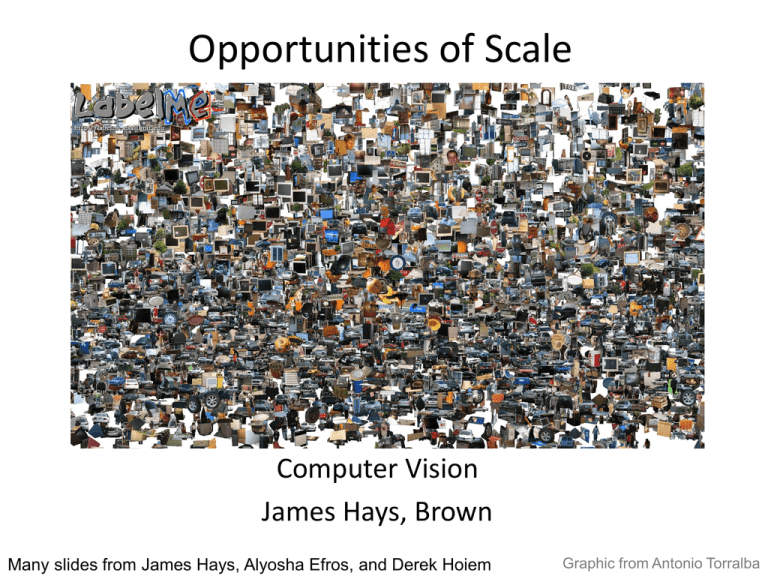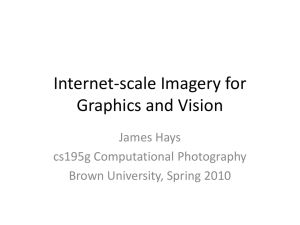Opportunities of Scale Computer Vision James Hays, Brown
advertisement

Opportunities of Scale Computer Vision James Hays, Brown Many slides from James Hays, Alyosha Efros, and Derek Hoiem Graphic from Antonio Torralba Opportunities of Scale: Data-driven methods • Today’s class – Scene completion – Im2gps • Next class – Recognition via Tiny Images – More recognition by association Google and massive data-driven algorithms A.I. for the postmodern world: – all questions have already been answered…many times, in many ways – Google is dumb, the “intelligence” is in the data Google Translate Chinese Room, John Searle (1980) If a machine can convincingly simulate an intelligent conversation, does it necessarily understand? In the experiment, Searle imagines himself in a room, acting as a computer by manually executing a program that convincingly simulates the behavior of a native Chinese speaker. Most of the discussion consists of attempts to refute it. "The overwhelming majority," notes BBS editor Stevan Harnad,“ still think that the Chinese Room Argument is dead wrong." The sheer volume of the literature that has grown up around it inspired Pat Hayes to quip that the field of cognitive science ought to be redefined as "the ongoing research program of showing Searle's Chinese Room Argument to be false. Big Idea • What if invariance / generalization isn’t actually the core difficulty of computer vision? • What if we can perform high level reasoning with brute-force, data-driven algorithms? Image Completion Example [Hays and Efros. Scene Completion Using Millions of Photographs. SIGGRAPH 2007 and CACM October 2008.] http://graphics.cs.cmu.edu/projects/scene-completion/ What should the missing region contain? Which is the original? (a) (c) (b) How it works • Find a similar image from a large dataset • Blend a region from that image into the hole Dataset General Principal Huge Dataset Input Image Images image matching Info from Most Similar Images Associated Info Hopefully, If you have enough images, the dataset will contain very similar images that you can find with simple matching methods. How many images is enough? Nearest neighbors from a collection of 20 thousand images Nearest neighbors from a collection of 2 million images Image Data on the Internet • Flickr (as of Sept. 19th, 2010) – 5 billion photographs – 100+ million geotagged images • Facebook (as of 2009) – 15 billion http://royal.pingdom.com/2010/01/22/internet-2009-in-numbers/ Image Data on the Internet • Flickr (as of Nov 2013) – 10 billion photographs – 100+ million geotagged images – 3.5 million a day • Facebook (as of Sept 2013) – 250 billion+ – 300 million a day • Instagram – 55 million a day Image completion: how it works [Hays and Efros. Scene Completion Using Millions of Photographs. SIGGRAPH 2007 and CACM October 2008.] The Algorithm Scene Matching Scene Descriptor Scene Descriptor Scene Gist Descriptor (Oliva and Torralba 2001) Scene Descriptor + Scene Gist Descriptor (Oliva and Torralba 2001) 2 Million Flickr Images … 200 total Context Matching Graph cut + Poisson blending Result Ranking We assign each of the 200 results a score which is the sum of: The scene matching distance The context matching distance (color + texture) The graph cut cost … 200 scene matches Which is the original? im2gps (Hays & Efros, CVPR 2008) 6 million geo-tagged Flickr images http://graphics.cs.cmu.edu/projects/im2gps/ How much can an image tell about its geographic location? Nearest Neighbors according to gist + bag of SIFT + color histogram + a few others Im2gps Example Scene Matches Voting Scheme im2gps Effect of Dataset Size Population density ranking High Predicted Density Low Predicted Density Where is This? [Olga Vesselova, Vangelis Kalogerakis, Aaron Hertzmann, James Hays, Alexei A. Efros. Image Sequence Geolocation. ICCV’09] Where is This? Where are These? 15:14, June 18th, 2006 16:31, June 18th, 2006 Where are These? 15:14, June 18th, 2006 16:31, June 18th, 2006 17:24, June 19th, 2006 Results • im2gps – 10% (geo-loc within 400 km) • temporal im2gps – 56%


